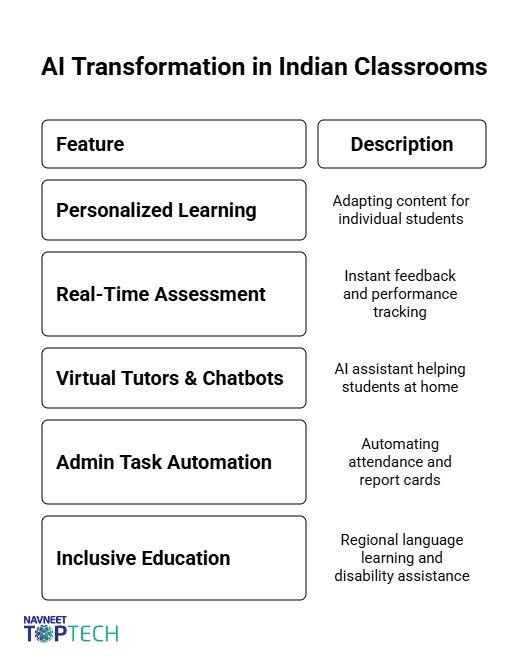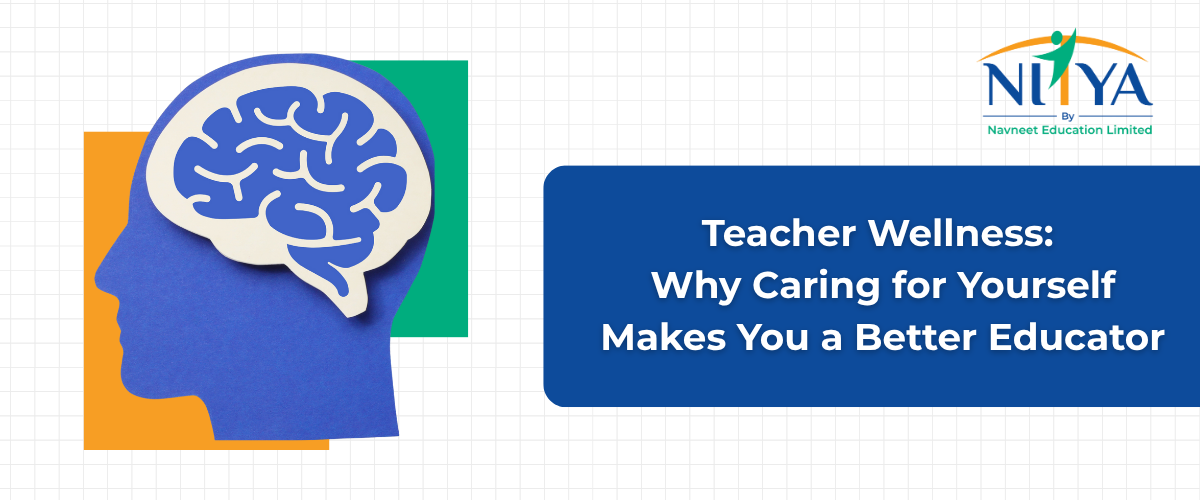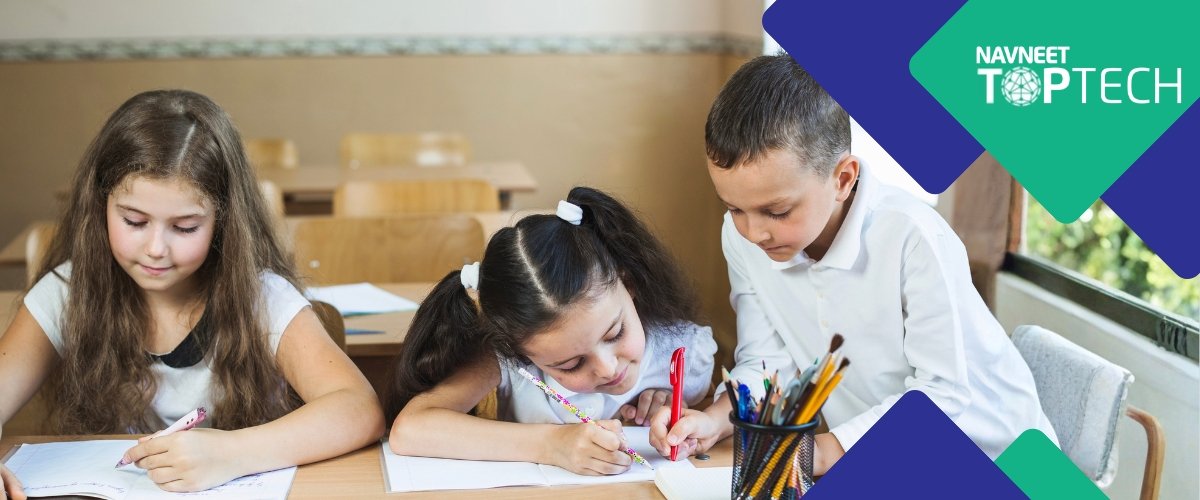Key Takeaways
- AI brings personalized learning, virtual tutors, and instant feedback to Indian classrooms.
- Helps teachers by automating administrative tasks and providing data-driven insights.
- Boosts accessibility with multilingual support and assistive technologies.
- Key challenges include infrastructure gaps, training needs, costs, and privacy concerns.
- NEP 2020 supports hybrid learning, and NAVNEET TOPTECH enables AI adoption through content, analytics, and ERP solutions.
Artificial Intelligence is changing the face of education around the world, from enhancing how students learn to improving how teachers teach. Globally, AI has become a powerful force in reshaping how education is delivered, accessed, and measured. For India, a country with one of the largest and most diverse education systems in the world, AI presents both an extraordinary opportunity and a formidable challenge.
In this blog, we explore how AI is transforming the Indian education system, the benefits and roadblocks along the way, and how NAVNEET TOPTECH is helping schools unlock the potential of AI-led learning. In India, where the education system is vast, diverse, and in many areas under-resourced, the integration of AI offers a once-in-a-generation opportunity to reshape learning outcomes at scale.
The Rise of AI in Indian Education
Over the past few years, India has witnessed a significant shift in how technology is used in education. The COVID-19 pandemic accelerated digital adoption by schools to quickly transition to remote learning. In that process, artificial intelligence moved from being a buzzword to a practical necessity. Tools powered by AI began supporting everything from content delivery to assessments and school management. As online learning became the norm, many schools turned to AI-powered tools to support both teaching and administration.
Urban schools were the first to adopt these solutions. Their access to better digital infrastructure, higher budgets, and exposure to global trends made it easier to integrate AI into everyday learning. These schools often have well-trained staff and tech-savvy students who can adapt quickly to new tools.
However, the interest in AI is now growing in rural India as well. School leaders in small towns and villages are seeing their potential to bridge learning gaps, especially where teacher shortages or large class sizes are an issue. While the infrastructure may still be catching up, there is a growing awareness that AI can bring personalized and scalable education to students who have traditionally been underserved.
With the right infrastructure and support, AI could level the playing field across India’s education system.

How AI Is Transforming the Indian Education System
- Personalized Learning
AI enables truly customized education experiences. By analyzing student performance data, AI can adjust the difficulty, pace, and type of content each learner receives. For example, a student struggling with math concepts can be shown simpler explanations or extra practice exercises, while another who’s ahead can be challenged with more complex problems. This individualized approach helps every student progress according to their ability, making learning more inclusive and effective.
- Real-Time Assessment
AI tools provide immediate feedback to students and actionable insights to teachers. Beyond basic evaluation, these tools track patterns, identify common errors, and suggest areas for improvement. Teachers can use this feedback to adapt their lessons on the fly, closing learning gaps before they widen.
- Virtual Tutors and Chatbots
AI-powered chatbots and virtual tutors offer students 24/7 support. Whether it’s answering homework questions, explaining difficult topics, or offering practice tests, these tools are becoming an essential learning companion. They’re especially useful in settings where access to teachers outside school hours is limited, giving students a lifeline for self-directed learning.
- Automation in Admin Tasks
AI is also streamlining school operations. It can automate tasks like attendance tracking, timetable generation, report cards, and fee collection. This reduces the burden on teachers and administrators, allowing them to focus more on student engagement and instructional quality.
Benefits of AI in Education in India
The benefits of AI in education are broad and measurable:
- Improved Learning Outcomes- Students get learning material suited to their abilities and pace. Interactive and gamified content keeps students more involved and better prepared.
- Support for Teachers- AI handles repetitive tasks, giving teachers more time to plan lessons, interact with students, and innovate in the classroom. Real-time data helps educators monitor student progress more effectively.
- Smarter Performance Tracking- AI-generated insights help educators and school leaders track performance trends, identify at-risk students, and allocate resources more effectively.
- Accessibility- AI tools can deliver content in multiple regional languages, making education more inclusive for diverse linguistic communities. Schools can deliver high-quality learning experiences even with limited staff or in large classrooms, thanks to AI-powered support systems.
With the right implementation, AI can turn classrooms into dynamic learning hubs that serve every student better.
Challenges of Implementing AI in Indian Education
Despite the promise, there are real challenges of AI in education in the Indian context:
- Digital Divide: Many schools, particularly in rural areas, lack reliable internet access, sufficient digital devices, and stable electricity.
- Affordability: AI solutions can be expensive, limiting access for low-income institutions. While AI tools are becoming more affordable, the upfront investment in hardware and training can be prohibitive for many schools.
- Teacher Training: Not all educators are trained to use AI tools effectively. Some may even resist the shift due to unfamiliarity or fear of being replaced. Educators need support and training to make full use of AI tools.
- Data Privacy: AI relies on collecting and analyzing student data. Without strict policies, there are risks of data misuse or breaches.
- Mindset Shifts: Resistance to change among educators, parents, or administrators can also slow adoption.
Addressing these challenges requires a coordinated effort from policymakers, educators, and technology providers.
Future of AI in Indian Education: What’s Next?
India’s National Education Policy (NEP) 2020 lays out a future-ready vision for the country’s education system, emphasizing technology integration, digital content, and experiential learning. AI is central to making this vision a reality.
Looking ahead, several trends are likely to shape the future of AI in Indian education:
- Hybrid Learning Models: Blending digital and classroom experiences will become the new normal, with AI helping manage the flow between both.
- Localized Content: AI tools will increasingly deliver content in regional languages and adapt to local curricula, making learning more relevant and effective.
- Bridging the Urban-Rural Divide: AI-powered mobile learning and low-bandwidth solutions will help extend quality education to remote areas.
- Inclusive Learning: AI can be used to support children with disabilities by offering personalized assistance, voice recognition, and other adaptive features.
- Smarter Schools: Institutions will use AI not just for teaching, but for decision-making, resource planning, and student well-being monitoring.
If implemented thoughtfully, AI can create a more inclusive and future-proof education system in India.
How NAVNEET TOPTECH Uses AI to Empower Schools
NAVNEET TOPTECH is leading the way in bringing AI to classrooms, particularly in the K–10 segment. Its solutions are built to align with the real needs of schools, teachers, and students, offering both content and systems that are AI-driven and easy to use.
Here’s how NAVNEET TOPTECH is using AI to make a difference:
- AI-Integrated Digital Content: The platform delivers interactive learning experiences that adapt to each student’s level.
- Performance Tracking: Real-time analytics help educators monitor student progress and tailor their teaching.
- School ERP Integration: From attendance to assessment reports, NAVNEET TOPTECH’S school ERP system simplifies management using AI automation.
- Interactive Classrooms: Engaging visuals, smart quizzes, and personalized feedback make every class more dynamic and effective.
By combining deep educational expertise with advanced technology, NAVNEET TOPECH is helping schools become smarter, more efficient, and more student-focused.
Final Take: Where India’s Classrooms Go from Here
Artificial intelligence is no longer a futuristic concept; it’s already reshaping education in India. With its power to personalize learning, automate systems, and support teachers, AI holds the key to transforming how education is delivered and experienced.
But the road ahead must be navigated thoughtfully. To make AI truly effective, India needs to address challenges like access, training, and infrastructure. Companies like NAVNEET TOPTECH are showing how innovation, when grounded in purpose, can drive real impact.
AI in education is not just about better tech, it’s about building a better future for every learner.




